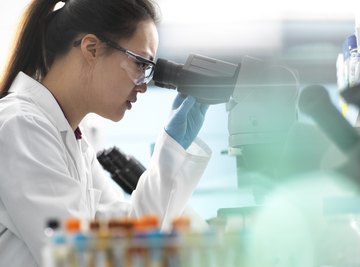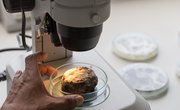
Living cells range from those of single-cell algae and bacteria, through multicellular organisms such as moss and worms, up to complex plants and animals including humans. Certain structures are found in all living cells, but single-cell organisms and cells of higher plants and animals are also different in many ways. Light microscopes can magnify cells so that the larger, more defined structures can be seen, but transmission electron microscopes (TEMs) are needed to see the tiniest cell structures.
Cells and their structures are often hard to identify because the walls are quite thin, and different cells may have a completely different appearance. Cells and their organelles each have characteristics that can be used to identify them, and it helps to use a high-enough magnification that shows these details.
For example, a light microscope with a magnification of 300X will show cells and some details but not the small organelles within the cell. For that, a TEM is needed. TEMs use electrons to create detailed images of tiny structures by shooting electrons through the tissue sample and analyzing the patterns as the electrons exit the other side. Images from TEMs are usually labeled with the cell type and magnification – an image marked "tem of human epithelial cells labeled 7900X" is magnified 7,900 times and can show cell details, the nucleus and other structures. Using light microscopes for whole cells and TEMs for smaller features permits the reliable and accurate identifaction of even the most elusive cell structures.
What Do Cell Micrographs Show?
Micrographs are the magnified images obtained from light microscopes and TEMs. Cell micrographs are often taken from tissue samples and show a continuous mass of cells and internal structures that are hard to identify individually. Typically such micrographs show a lot of lines, dots, patches and clusters that make up the cell and its organelles. A systematic approach is needed for identifying the various parts.
It helps to know what distinguishes the different cell structures. The cells themselves are the largest closed body in the micrograph, but inside the cells are many different structures, each with its own set of identifying features. A high-level approach where closed boundaries are identified and closed shapes are found helps isolate the components on the image. It is then possible to identify each separate part by looking for unique characteristics.
Micrographs of Cell Organelles
Among the most difficult cell structures to identify correctly are the tiny membrane-bound organelles within each cell. These structures are important for cell functions, and most are small sacs of cell matter such as proteins, enzymes, carbohydrates and fats. They all have their own roles to play in the cell and represent an important part of cell study and cell structure identification.
Not all cells have all types of organelles, and their numbers vary widely. Most of the organelles are so small that they can only be identified on TEM images of organelles. While shape and size help distinguish some organelles, it is usually necessary to see the interior structure to be sure what type of organelle is shown. As with the other cell structures and for the cell as a whole, the special features of each organelle makes identification easier.
Identifying Cells
Compared to the other subjects found in cell micrographs, cells are by far the largest, but their limits are often surprisingly difficult to find. Bacterial cells are independent and have a comparatively thick cell wall, so they can usually be seen easily. All other cells, especially those in the tissues of higher animals, only have a thin cell membrane and no cell wall. On micrographs of tissue there are often only faint lines showing the cell membranes and limits of each cell.
Cells have two characteristics that make identification easier. All cells have a continuous cell membrane that surrounds them, and the cell membrane encloses a number of other tiny structures. Once such a continuous membrane is found and it encloses many other bodies that each have their own internal structure, that enclosed area can be identified as a cell. Once the identity of a cell is clear, identification of the interior structures can proceed.
Finding the Nucleus
Not all cells have a nucleus, but most of the ones in animal and plant tissues do. Single-celled organisms such as bacteria don't have a nucleus, and some animal cells such as human mature red blood cells don't have one either. Other common cells such as liver cells, muscle cells and skin cells all have a clearly defined nucleus inside the cell membrane.
The nucleus is the biggest body inside the cell, and it is usually more or less a round shape. Unlike the cell, it doesn't have a lot of structures inside it. The biggest object in the nucleus is the round nucleolus that is responsible for making ribosomes. If the magnification is high enough, the wormlike structures of the chromosomes inside the nucleus can be seen, especially when the cell is preparing to divide.
What Ribosomes Look Like and What They Do
Ribosomes are tiny clumps of protein and ribosomal RNA, the code according to which the proteins are manufactured. They can be identified by their lack of membrane and by their small size. In micrographs of cell organelles, they look like little grains of solid matter, and there are many of these grains scattered throughout the cell.
Some ribosomes are attached to the endoplasmic reticulum, a series of folds and tubules near the nucleus. These ribosomes help the cell produce specialized proteins. At very high magnification it may be possible to see that the ribosomes are made up of two sections, the larger part composed of RNA and a smaller cluster made up the the manufactured proteins.
The Endoplamic Reticulum Is Easy to Identify
Found only in cells that have a nucleus, the endoplasmic reticulum is a structure made up of folded sacs and tubes located between the nucleus and the cell membrane. It helps the cell manage the exchange of proteins between the cell and the nucleus, and it has ribosomes attached to a section called the rough endoplasmic reticulum.
The rough endoplasmic reticulum and its ribosomes produce cell-specific enzymes such as insulin in pancreas cells and antibodies for white blood cells. The smooth endoplasmic reticulum has no ribosomes attached and produces carbohydrates and lipids that help keep the cell membranes intact. Both parts of the endoplasmic reticulum can be identified by their connection to the nucleus of the cell.
Identifying Mitochondria
Mitochondria are the powerhouses of the cell, digesting glucose to produce the storage molecule ATP that cells use for energy. The organelle is made up of a smooth outer membrane and a folded inner membrane. Energy production takes place through a transfer of molecules across the inner membrane. The number of mitochondria in a cell depends on the cell function. Muscle cells, for example, have many mitochondria because they use up a lot of energy.
Mitochondria can be identified as smooth, elongated bodies that are the second largest organelle after the nucleus. Their distinguishing feature is the folded inner membrane that gives the interior of the mitochondria its structure. On a cell micrograph, the folds of the inner membrane look like fingers jutting into the interior of the mitochondria.
How to Find Lysosomes in TEM Images of Organelles
Lysosomes are smaller than mitochondria, so they can only be seen in highly magnified TEM images. They are distinguished from ribosomes by the membrane that contains their digestive enzymes. They can often be seen as rounded or spherical shapes, but they may also have irregular shapes when they have surrounded a piece of cell waste.
The function of lysosomes is to digest cell matter that is no longer required. Cell fragments are broken down and expelled from the cell. Lysosomes also attack foreign substances that enter the cell and as such are a defense against bacteria and viruses.
What Golgi Bodies Look Like
Golgi bodies or Golgi structures are stacks of flattened sacks and tubes that look like they have been pinched together in the middle. Each sack is surrounded by a membrane that can be seen under sufficient magnification. They sometimes look like a smaller version of the endoplasmic reticulum, but they are separate bodies that are more regular and are not attached to the nucleus. Golgi bodies help produce lysosomes and convert proteins into enzymes and hormones.
How to identify Centrioles
Centrioles come in pairs and are usually found near the nucleus. They are tiny cylindrical bundles of protein and are a key for cell division. When viewing many cells, some may be in the process of dividing, and the centrioles then become very prominent.
During division, the cell nucleus dissolves and the DNA found in the chromosomes is duplicated. The centrioles then create a spindle of fibers along which the chromosomes migrate to opposite ends of the cell. The cell can then divide with each daughter cell receiving a full complement of chromosomes. During this process, the centrioles are at either end of the spindle of fibers.
Finding the Cytoskeleton
All cells have to maintain a certain shape, but some have to stay stiff while others can be more flexible. The cell holds its shape with a cytoskeleton made up of different structural elements depending on cell function. If the cell is part of a larger structure such as an organ that has to keep its shape, the cytoskeleton is made up of stiff tubules. If the cell is allowed to yield under pressure and doesn't have to keep its shape completely, the cytoskeleton is lighter, more flexible and made up of protein filaments.
When viewing the cell on a micrograph, the cytoskeleton shows up as thick double lines in the case of tubules and thin single lines for filaments. Some cells may have hardly any such lines, but in others, open spaces may be filled with the cytoskeleton. When identifying cell structures, it's important to keep the organelle membranes separate by tracing their closed circuit while the lines of the cytoskeleton are open and cross the cell.
Putting It All Together
For a complete identification of all cell structures, several micrographs are needed. The ones showing the whole cell, or several cells, will not have enough detail for the smallest structures such as chromosomes. Several micrographs of organelles with a progressively higher magnification will show the larger structures such as mitochondria and then the smallest bodies such as the centrioles.
When first examining a magnified tissue sample, it may be difficult to immediately see the different cell structures, but tracing the cell membranes is a good start. Identifying the nucleus and larger organelles such as the mitochondria is often the next step. In the higher-magnification micrographs, the other organelles can often be identified by a process of elimination, looking for key distinguishing characteristics. The numbers of each organelle and structure then give a clue regarding the function of the cell and its tissues.
References
About the Author
Bert Markgraf is a freelance writer with a strong science and engineering background. He has written for scientific publications such as the HVDC Newsletter and the Energy and Automation Journal. Online he has written extensively on science-related topics in math, physics, chemistry and biology and has been published on sites such as Digital Landing and Reference.com He holds a Bachelor of Science degree from McGill University.
